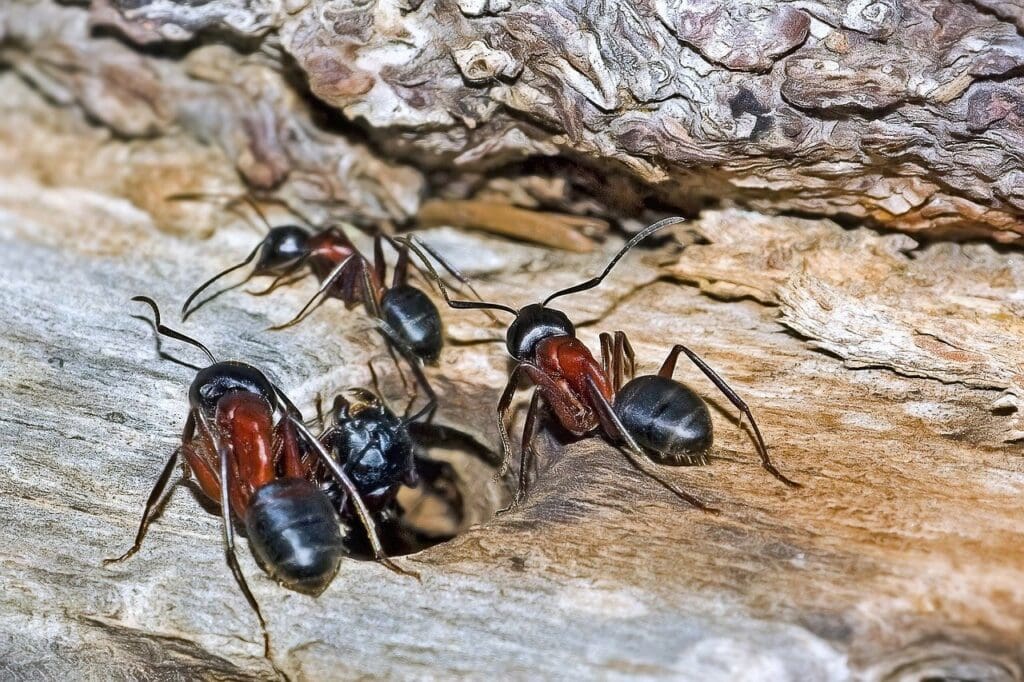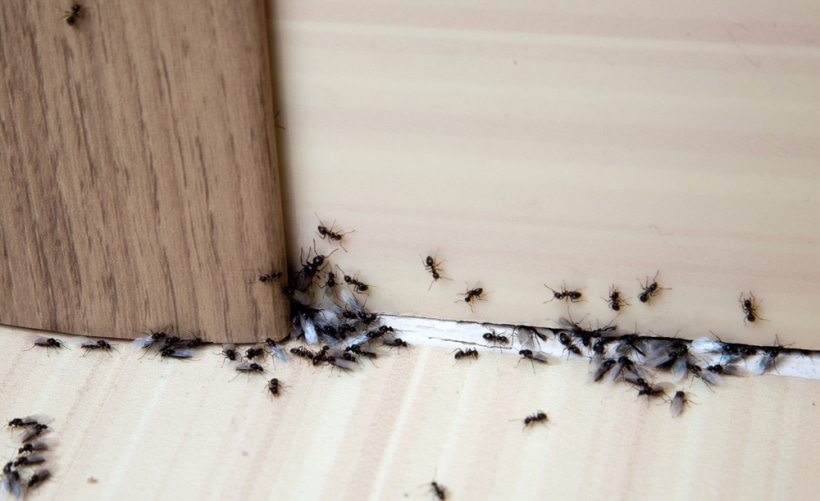4 Types of Ants Every Homeowner Should Know (with Pictures)
-
Brooke Bundy
- Last updated:

It would hardly seem like summer without spotting a group of ants streaming into your home at some point. Ants are resilient creatures, tiny sugar-addicts who can crawl through almost any crack. Some types of ants, such as the fire ant, may even be dangerous if you’re stung.
If you live in North America, you’ll probably see these guys in your house at some point. Learn how to recognize them by their appearance and by what they’re drawn to to determine which ones are lingering around your door. Here are ways you can identify the next guests to your picnic, as well as methods to put them on the uninvited list.
The 4 Types of Ants Every Homeowner Should Know
1. Carpenter Ants

| Scientific Name: | Camponotus pennsylvanicus |
| Color: | Black |
| Size: | ¼ – ½ inch |
| Wings: | Yes, in reproductive males and females (not queens) |
Carpenter ants tend to have thick, black bodies and are bigger than some of the other familiar types of ants you might find in your home. Like termites, carpenter ants can cause structural damage to your home by eating wood. Another way to determine whether you have the carpenter variety is to check for small trails of wood shavings by wooden objects in your home such as the trim on exterior doorways and windows. Carpenter ants don’t sting; instead, they bite and spray formic acid. However, they rarely bite humans and usually, it’s only when they feel like their nest is threatened.
2. Odorous House Ants

| Scientific Name: | Tapinoma sessile |
| Color: | Dark brown black |
| Size: | 1/8 inch |
| Wings: | Only during breeding season in the spring/summer |
Commonly referred to as “sugar ants,” these house ants shouldn’t be confused with the real sugar ant species that lives in Australia. Odorous house ants earned their name by having a sweet, rotten smell when crushed, a smell they might possess because of all the sugar they’re known to consume. A menace to your pantry, odorous house ants don’t sting or bite, but they’ll raid your cookie jar any day, especially during the warmer months when they’re most active.
3. Pavement Ants

| Scientific Name: | Tetramorium caespitum |
| Size: | 1/10 inch |
| Wings: | Reproductive males and females in June and July |
These ants can actually eat termites! Since they also rarely bite and their stinger can’t penetrate human skin, they’re much less of a nuisance than the other types of ants we’ve discussed. The only problem with pavement ants is that they are also attracted to sugar. They like meadows, rocks, and patios, and can be seen tumbling over sidewalks in urban areas.
4. Red Imported Fire Ant

| Scientific Name: | Solenopsis invicta |
| Color: | Reddish brown |
| Size: | 1/16 – 1/5 inch |
| Wings: | Reproductive males and females |
You don’t want to mess with these guys, or you’ll get burned by the venom in their stings. Fire ants can be characterized by their manic, aggressive behavior and reddish-brown color. If you find a fire ant nest near your home, you want to eradicate the problem as soon as possible. Individuals who are allergic to fire ant stings may even need medical treatment if bitten.
How to Eliminate Ants in Your Home
There are two main strategies to mitigating an ant problem in your home: sealing unnecessary openings and destroying nests. Ants who are mostly looking for sugar such as odorous house ants and pavement ants will probably be the worst in the summer, especially in the kitchen, but ants may also seek shelter during the cold months of the winter.
Making sure your doors and windows are tight will prevent ants from marching in. You might also try a 50/50 spray of water and vinegar around your doorways because ants don’t like the smell. Securing any open food and frequently taking out the trash will eliminate any tantalizing smells such as rotting banana peels or sticky jam.

If you do find them trailing down your hallway, follow them to find their nest. If the nest is outside, you might consider sprinkling a natural solution such as diatomaceous earth onto the nest. Diatomaceous earth is made up of crushed exoskeletons from fossilized plankton. These tiny shards penetrate ant’s exoskeletons and kill them—while keeping your property free from dangerous pesticides. Diatomaceous earth is highly effective and is perfectly safe to use around children and pets once it’s been applied. Just wear a mask while you’re spreading it because the tiny shards are dangerous to inhale. Alternatively, you could use a pesticide or call an exterminator.
If the nest is inside your home, such as under the carpet, we recommend calling an exterminator to deal with the problem and keeping pets and small children away from the area until they arrive. You can also try to fix the problem yourself by applying the 50/50 water and vinegar spray, or sprinkling ground cinnamon on the ant bed, which will cause them to suffocate.
Conclusion
As annoying as they might be, ants are pretty much guaranteed to be your house guest at some point. Learning how to identify which of the four main types of ants is crawling on your kitchen counter can help you fix the problem sooner. In general, keeping food closed and sealing gaps in the exterior doors and windows should reduce the number of ants who treat your house like a B&B.
Featured Image Credit: cp17, Pixabay
Contents
